
Germany - DB, Oberweißbacher Berg- und Schwarzatalbahn
For a full scale picture, please click on the picture shown !
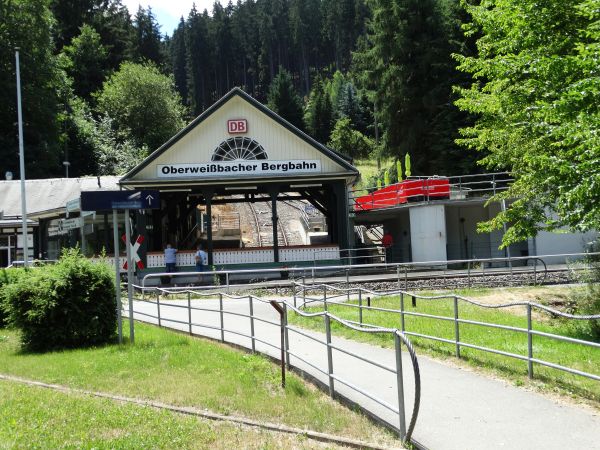
This is the Obstfelderschmiede station, the lower end of the Oberweißbacher Bergbahn. The whole Oberweißbacher
Berg- und Schwarzatalbahn complex consists of one quite normal, normal gauge railway, the Schwarzatalbahn, from Rottenbach
to Katzhütte, which thereby passes by the valley station of the Oberweißbacher Bergbahn funicular at Obstfelderschmiede.
The Schwarzatalbahn train brings tourists and other passengers with diesel railbuses from bigger towns and cities to Obstfelderschmiede. Next
there is the Oberweißbacher Bergbahn funicular, which is a peculiar broad gauge funicular, which takes both passengers as well as heavy loads
of cargo, or even complete normal gauge train wagons, up from Obstfelderschmiede up to the village of Lichtenhain high up there on the
highlands of Thüringen (Thuringia).
It's a very peculiar funicular with up to 25% steep slopes, 1,4 km long. Finally, high up there, there is a normal gauge railway between
the village of Lichtenhain to the village of Cursdorf. It is a 2,6 km long normal gauge adhesion only railway, but it operates trains
with electric motor wagons specifically built for just this one place, the DB class ET479, nowadays Br479. The Br479 is a small motorised
electric wagon, which runs on 600V DC. Their top speed is a modest 50 km/h and they have 24 seats. They are originally from the year 1923,
(one from 1909) but they were thoroughly modified and modernised 1970/1982. There are three of them. The oldest one was a tram
dating back to 1909 and all three have actually very varied backgrounds. They are heavily modified to become trains for the intended line.
The tram origin of the first motor wagon is also why the train line still today works with the tram-specific, not typical, voltage of only
600V DC.
And, up there at Lichtenhain, the electric railway to Cursdorf is not the only railway. Not organisationally belonging to the complex of the
Oberweißbacher Berg- und Schwarzatalbahn, there is also a private narrow gauge so called Waldbahn, forest reilway, which now occasionally
offers tourist rides. There is plenty to see at this formerly East German mountain railway complex.
This is the Obstfelderschmiede station, the lower starting point of the funicular of Oberweißbacher Bergbahn.
Picture 2.7.2019 by Ilkka Siissalo.
Schwarzatalbahn
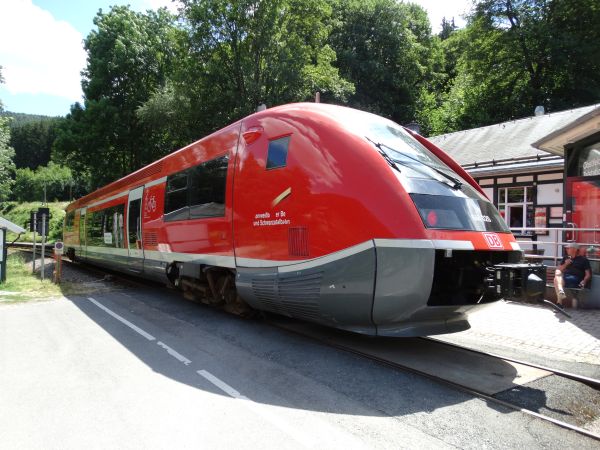
"Down there", in the valley below, runs the Schwarzatalbahn between Rottenbach and Katzhütte.It's a small "Nebenbahn", side line. Today
that service is normally handled by two French built diesel railbuses of the class Br641, known also as "Baleine", blue whale, according
to their origin and their original blue SNCF colours in France, Sometimes there are still old DR / DDR age small railbuses, so called
"Ferkeltaxi" (piglet taxi) wagons replacing them in case one or the other of the two French made railbuses happens to be in repair. They
bear text stickers "Fürstenkutsche zur Bergbahn". Fürstenkutsche means a coach for the "first", the king or the biggest boss, bringing him
or her to the mountain railway.
The class Br641 trains are built by Alstom in France. They were built since 1999 and have been in use not only by SNCF in France, but also
(shortly) by CFL in Luxemburg and more permanently by DB in Germany. In Germany they are common in Thüringen and also in the Basel area in
Baden-Württemberg as well as in the Saarland area close to France and Luxemburg.
Picture from Obstfelderschmiede in Thüringen (Thuringia) 2.7.2019 by Ilkka Siissalo.
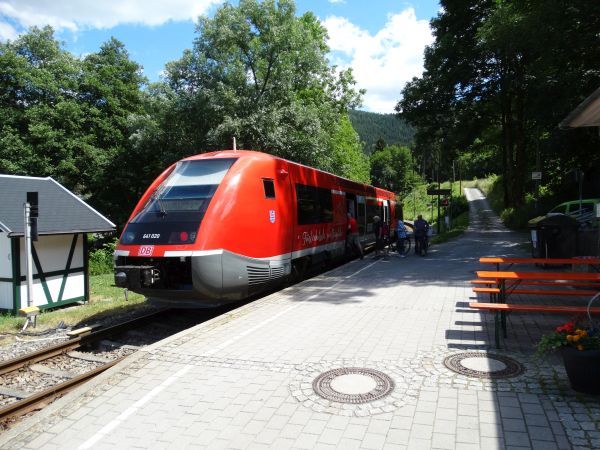
Another picture of a Br641 "Baleine" railbus bringing tourists to and from the Oberweißbacher Bergbahn at Obstfelderschmiede.
Picture 2.7.2019 by Ilkka Siissalo.
Oberweißbacher Bergbahn funicular
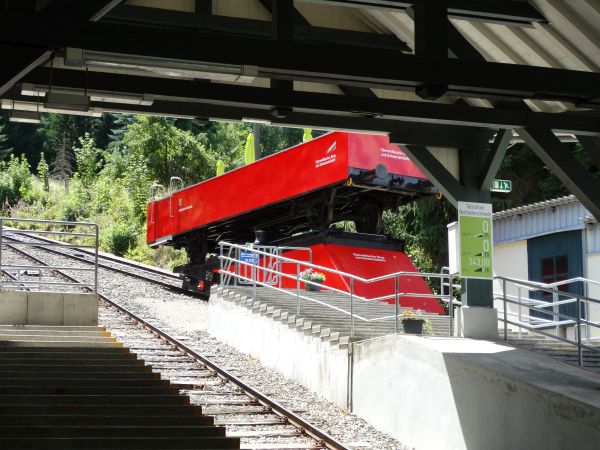
The Oberweißbacher Bergbahn funicular is quite special. Normal funiculars have two similar wagons at the end of a single metal wire.
But in this case at the one end of the wire is a wagon designed for passenger use, but at the opposite end is just a platform, which
allows basically any normal gauge railway wagon to be hauled up from Obstfelderschmiede up to the upper end station to Lichtenhain,
where a normal gauge electric railway connects to Cursdorf and another, private, narrow gauge forest railway connects to the other
direction. This is the other end wagon of the funicular, or rather, platform wagon, onto which one can basically load whatever normal
gauge railway wagon one wishes. During normal summer time, like here, an open panorama wagon for tourists is preferred. But during
bad weather often a closed old passenger wagon is used. There is a specifically built railway line which allows easily loading
whatever normal gauge railway wagon onto the funicular platform wagon.
Here we see an open wagon with benches for tourists, so called cabriolet wagon, parked on the funicular platform to make it suitable
for passenger transport when the weather is nice.
Picture from Obstfelderschmiede 2.7.2019 by Ilkka Siissalo.
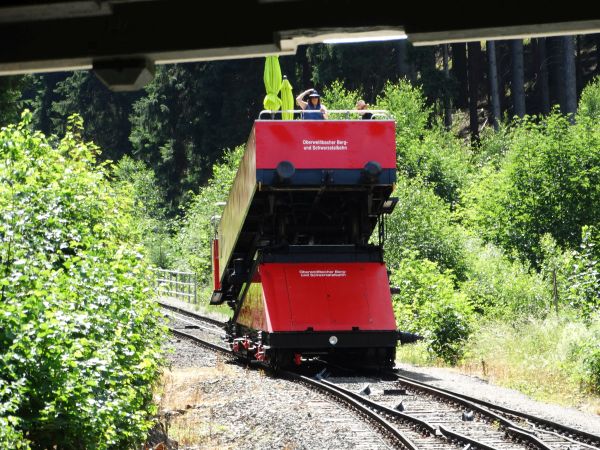
There the platform wagon with its touristic cabriolet load goes.
Picture from Obstfelderschmiede 2.7.2019 by Ilkka Siissalo.
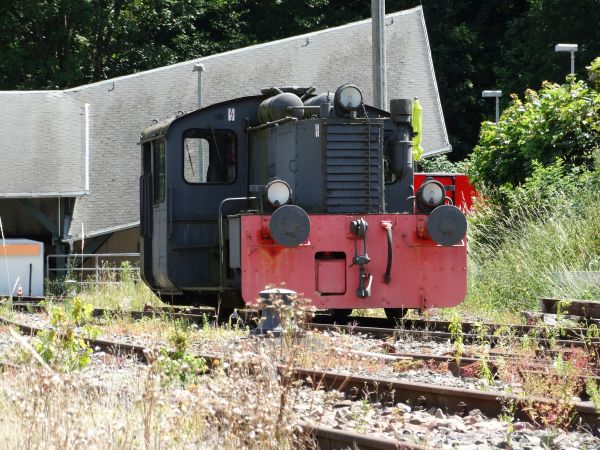
At both ends of the funicular line there is a rail connection leading to the platform wagon of the funicular. Down at Obstfelderschmiede an
old Köf II locomotive is ready whenever a wagon needs to be loaded or unloaded to or from the funicular. The old Köf is still in the black
colours of communist East Germany's DR. At DR these Köf II's were called Br100.
Picture from Obstfelderschmiede 2.7.2019 by Ilkka Siissalo.
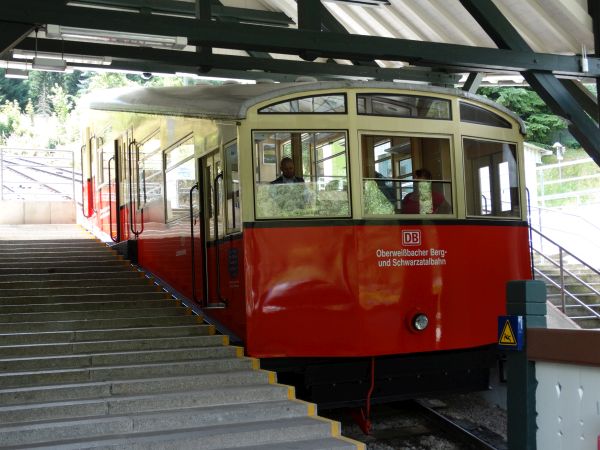
At the other end of the funicular wire there is a passenger wagon which can take up to 100 persons. There are seats for 42 people.
The wagon is extremely broad, almost 4 metres. The whole funicular system is built to be very broad. Gauge is 1800 mm. The line is
1388 m long and it rises up by 323 metres. It takes typically 18 minutes to ride the funicular line. There's no air conditioning, so
even 18 minutes can be a long time...
Picture from Obstfelderschmiede 2.7.2019 by Ilkka Siissalo.
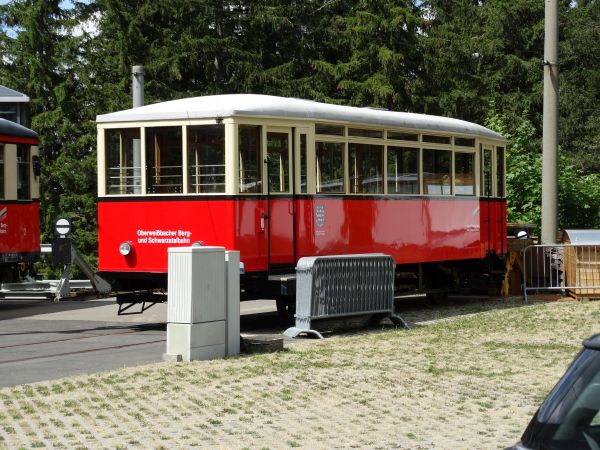
This old unmotorised wagon is often used on the funicular's platform wagon instead of the open "cabriolet" wagon during bad weather
when there are no cargo wagons to be transported, but people need to ride on the platform wagon.
Picture from Lichtenhain, the upper station of the funicular, 2.7.2019 by Ilkka Siissalo.
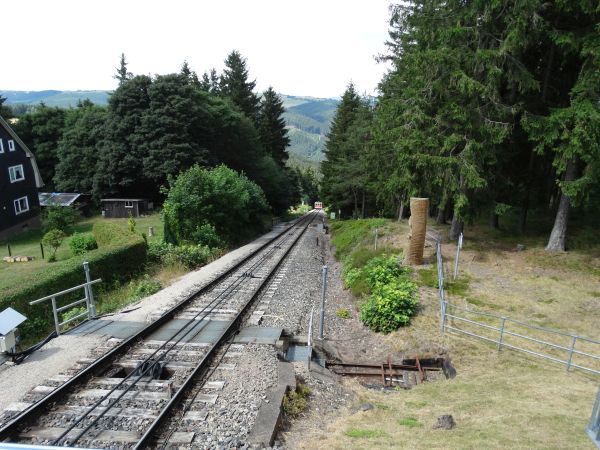
A view from Lichtenhain upper station down along the steep funicular line. The passenger coach is just approaching, deep down, barely
visible.
Picture from Lichtenhain 2.7.2019 by Ilkka Siissalo.
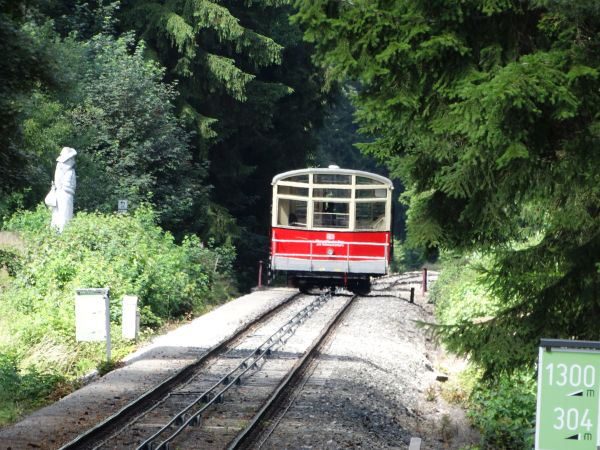
A couple of minutes later the approaching passenger coach is already fairly near by.
Picture from Lichtenhain 2.7.2019 by Ilkka Siissalo.
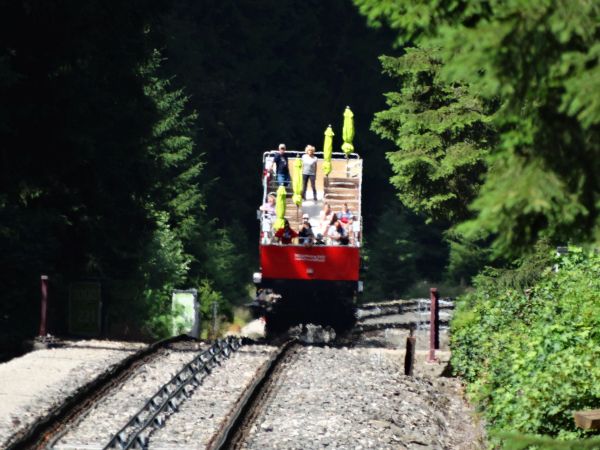
Half an hour later from the picture above, the passenger wagon has already moved back down towards Obstfelderschmiede and now the platform
wagon with its touristic "cabriolet" wagon load is approaching Lichtenhain upper station.
Picture from Lichtenhain 2.7.2019 by Ilkka Siissalo.
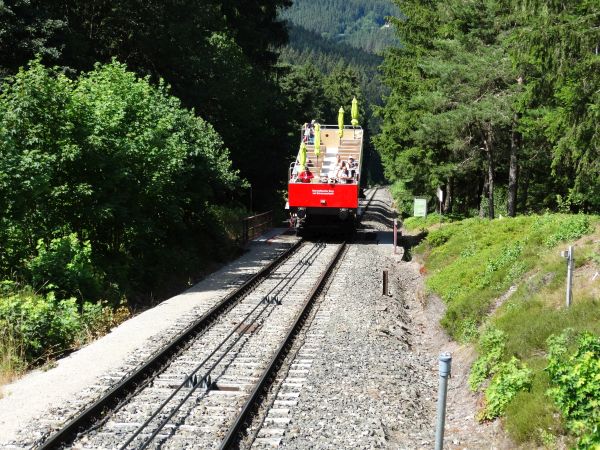
Minutes later, the "cabriolet" wagon is already close to Lichtenhain upper station.
Picture from Lichtenhain 2.7.2019 by Ilkka Siissalo.
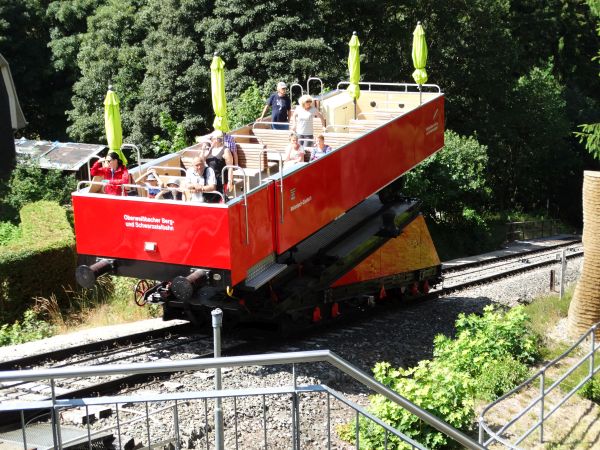
Even closer, this picture shows clearly how the "cabriolet" wagon is just a regular cargo wagon with benches, anchored on top of the
platform wagon of the funicular.
Picture from Lichtenhain 2.7.2019 by Ilkka Siissalo.
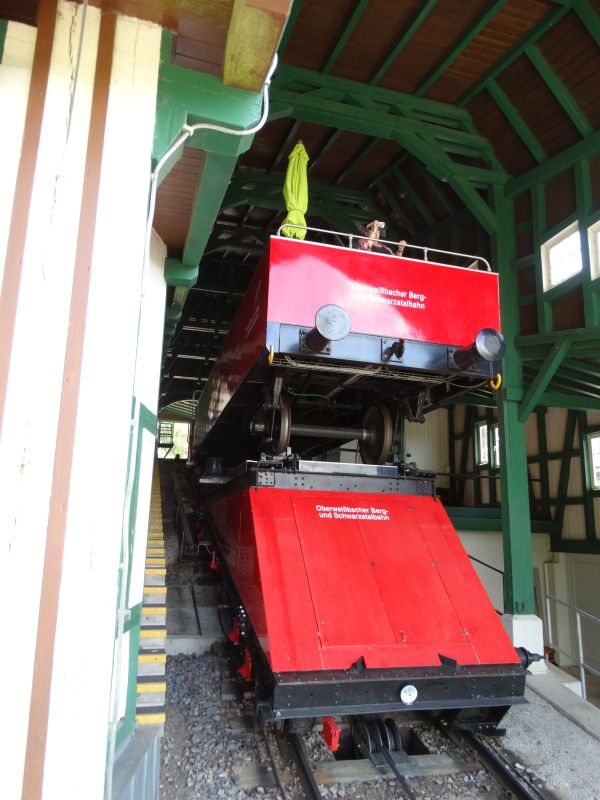
...and from behind, when the platform wagon arrives at the Lichtenhain upper station, the locking systems that keep the normal railway
wagon on top of the platform wagon are clearly visible.
Picture from Lichtenhain 2.7.2019 by Ilkka Siissalo.
Flachstrecke - The flatland railway high up between Lichtenhain and Cursdorf
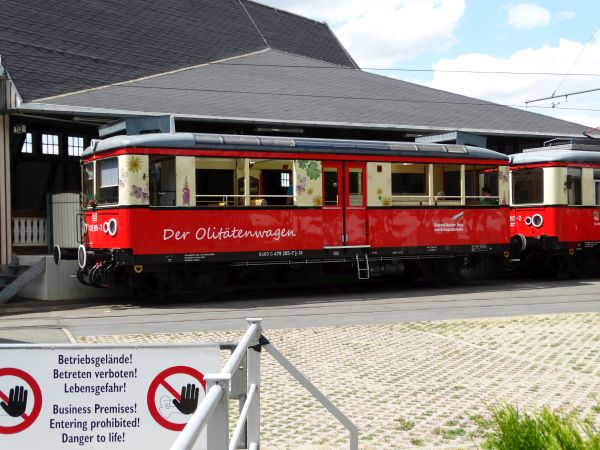
The village of Lichtenhain which is at the upper end of the long funicular, is the starting point of the "Flachstrecke", a normal
gauge, normal adhesion railway which was built to serve a whole region high up there. Lichtenhain is 668 m over sea level. That Flachbahn
is the "kingdom" of the Br479. Originally the very first Br479 was a Leipzig tram from 1909, but they all have gone through several thorough
renovations, especially in 1955, 1984 and in 2008. All of these have changed the looks of the wagons thoroughly. Not all of these Br479
wagons were originally trams. In fact, all three motor wagons have a very different origin. It was those years when DR of DDR did not have
the right to build totally new wagons or trains, so that they had to call the new ones "rebuildings" of old wagons, even as often very
little remained from the original wagons. Anyway, the result of these "rebuildings" was a set of three almost similar wagons now called
Br479. They have a lot of common parts with the Berlin S-Bahn wagons of the class Baureihe 476/477 (formerly Br276).
479 205 was originally a motorwagon with a gazolene engine ("Verbrennungstriebwagen") of the Niederbarnimer Eisenbahn.
It was converted first in 1974 into a steering cab wagon for the Oberweißbacher Bergbahn, but then in 1983-84 rebuilt to become a similar
electric motor wagon like the other Br479 wagons were. In 2015-16 it was again thoroughly rebuilt with bigger windows and it got the name
"Der Olitätenwagen". It was relaunched to service as Der Olitätenwagen in the summer of 2016. It carries pictures of this region, called the
Olitätenregion.
Picture from Lichtenhain 2.7.2019 by Ilkka Siissalo.
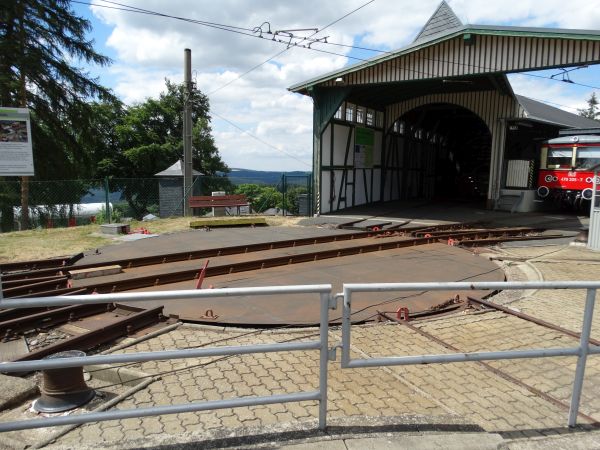
This turntable just outside the upper station of the funicular at Lichtenhain is used not only for turning of the motor wagons of the
Flachstrecke, but the one rail pair which looks like leading to a garage (Note: No overhead catenary leading there.) is actually the one
that leads to the platform wagon of the funicular and allows wagons to be moved to or from the funicular in order to move them down the
hill to Obstfelderschmiede or up from there if necessary. That is the only way down to connect with the outside world for Oberweißbacher
Flachstrecke wagons.
Picture from Lichtenhain 2.7.2019 by Ilkka Siissalo.
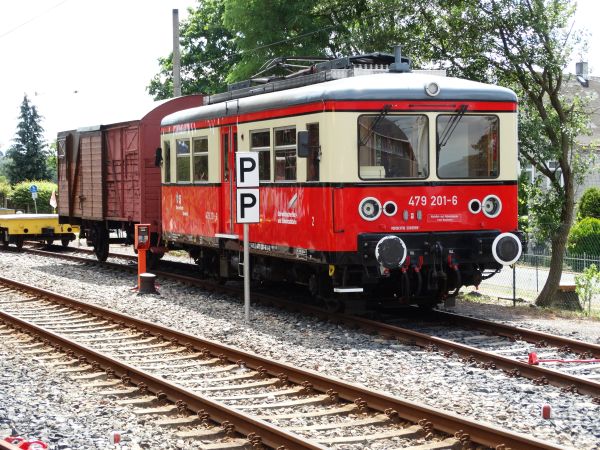
479 201 is the very first of these Br479 motor wagons. Three thorough rebuildings have changed it into what it is today, but in the beginning
it was a Leipzig tram from 1909. Or... Let's put it straight: Some minor parts of it used to belong to a Leipzig tram from 1909.
Picture from Lichtenhain 2.7.2019 by Ilkka Siissalo.
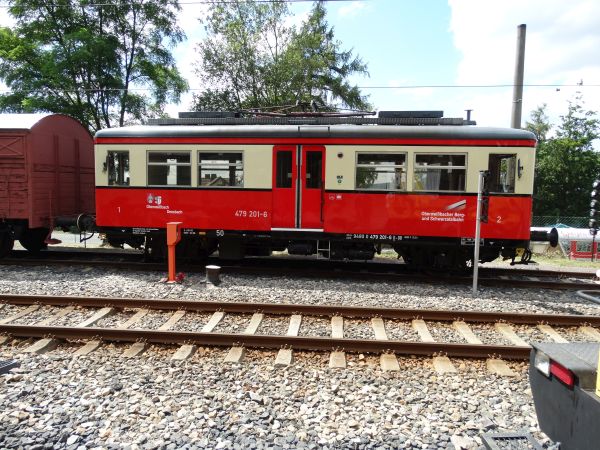
479 201 seen from its side.
Picture from Lichtenhain 2.7.2019 by Ilkka Siissalo.
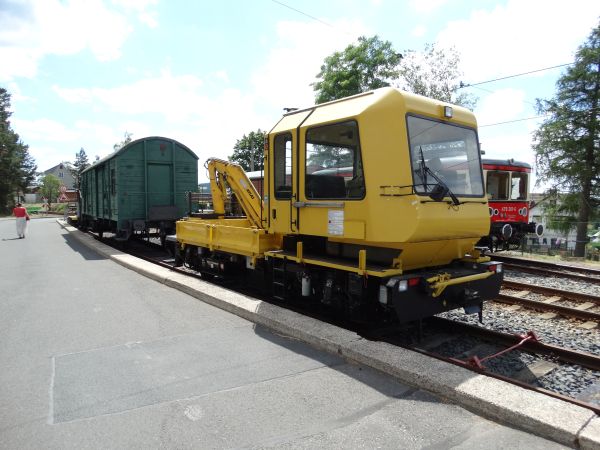
The "Flachstrecke" from Lichtenhain to Cursdorf is only less than 3 km long, but it nevertheless needs repairs. And as the railway is
besides the funicular at Lichtenhain totally separated from the rest of the DB network, there is one modern rail truck based at Lichtenhain.
This is a type SKL 26 LK "Gleiskraftwagen".
Picture from Lichtenhain 2.7.2019 by Ilkka Siissalo.
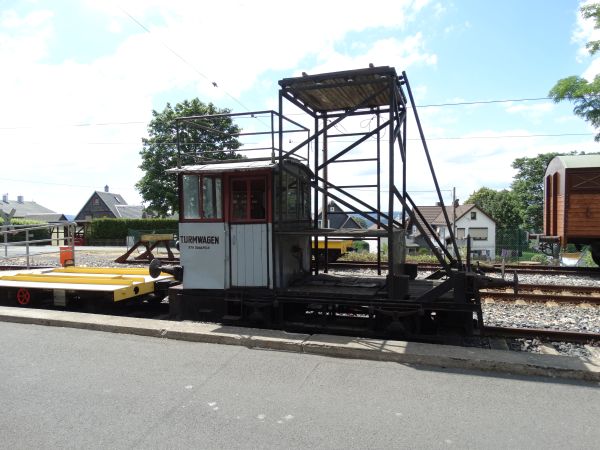
There are more spectacular catenary wire installation vehicles in Germany than this Turmwagen, but it may well be enough for one less than
3 km long 600V installation to fix its overhead installations.
Picture from Lichtenhain 2.7.2019 by Ilkka Siissalo.
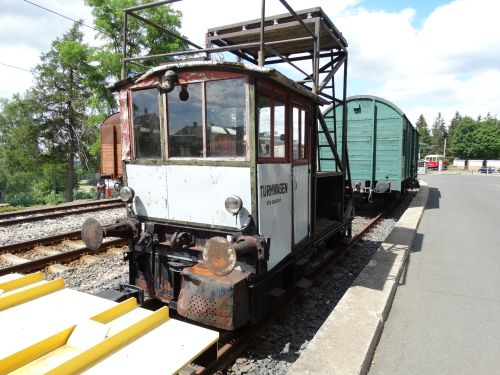
The same Turmwagen catenary wire installation vehicle as shown above. It may not be modern or fancy, but it may be quite enough for a
2,6 km long line.
Picture from Lichtenhain 2.7.2019 by Ilkka Siissalo.
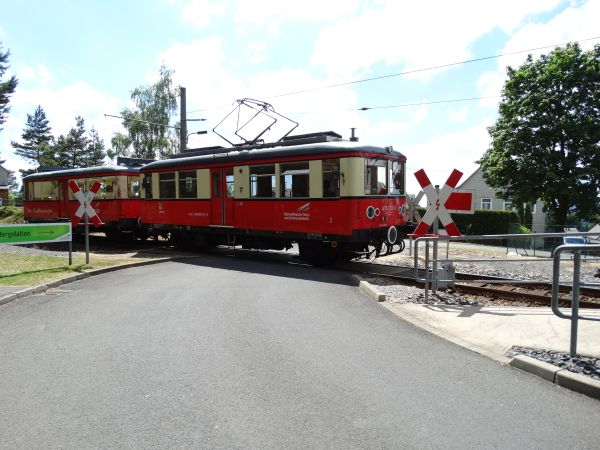
A standard train according to the regular timetable from Lichtenhain towards Cursdorf has just left Lichtenhain and is here crossing the level
crossing of a very narrow and curvy road leading down towards Obstfelderschmiede. The train consists of one steering
cab coach and one of the three 600V DC Br479 motor wagons, this time the 479 203.
Picture from Lichtenhain 2.7.2019 by Ilkka Siissalo.
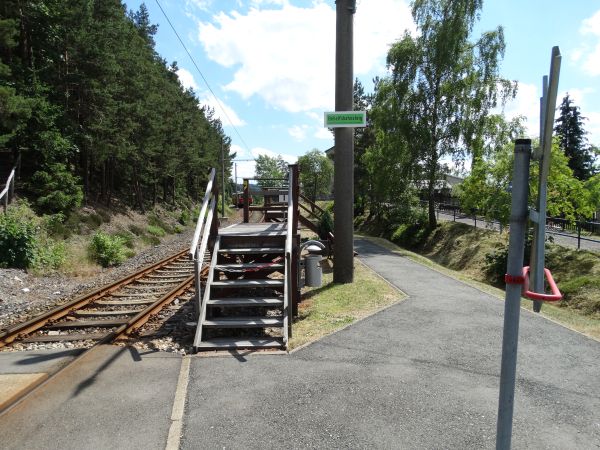
The Br479 trains are far from being "low-floor" and currently there is not even a proper platform for passengers available at Lichtenhain.
This is the temporary "platform" to board a train by the road level crossing.
Picture from Lichtenhain 2.7.2019 by Ilkka Siissalo.
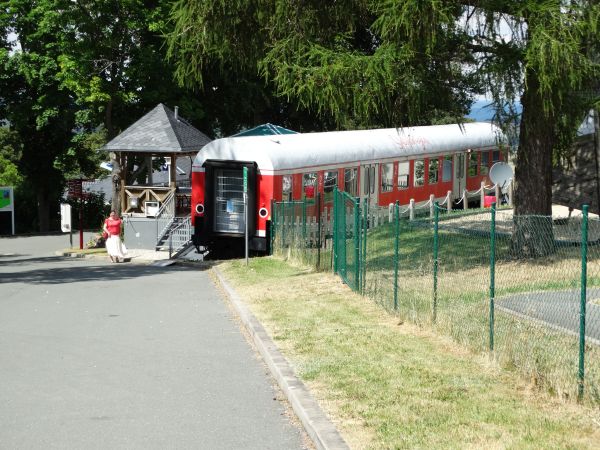
They have even managed to haul a full-sized "Silberling" local traffic coach uphills to Lichtenhain, probably with the funicular's
platform wagon. It is today used as a cafeteria for tourists at the Lichtenhain station high up there.
Picture from Lichtenhain 2.7.2019 by Ilkka Siissalo.
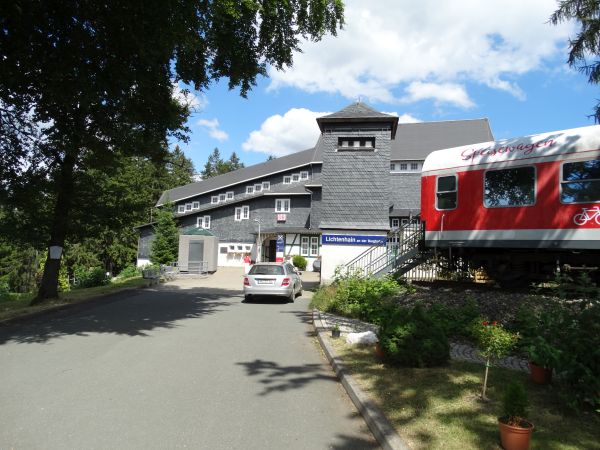
Lichtenhain an der Bergbahn station seen from its side. As is evident, the funicular arrives from the left with its 25% gradient.
The Flachbahn normal trains leave from behind the building on the upper right. And the private Waldbahn narrow gauge railway ends
right behind the building seen from here. And the DB red "Silberling" coach used for a cafeteria is also visible.
Picture from Lichtenhain 2.7.2019 by Ilkka Siissalo.
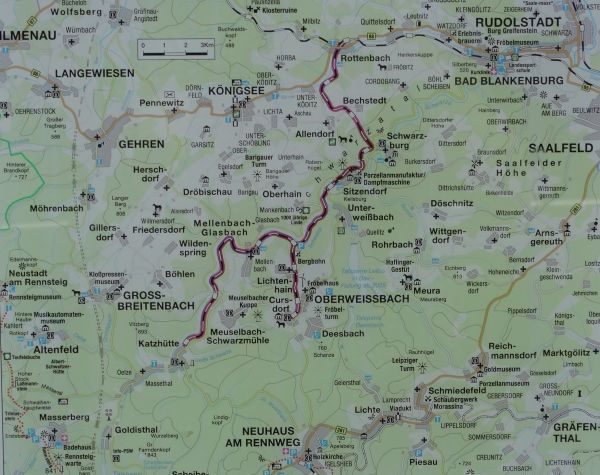
A map piece photographed from the station wall at Lichtenhain, showing the whole region of the Oberweißbacher Berg- und Schwarzatalbahn.
Picture from Lichtenhain station 2.7.2019 by Ilkka Siissalo.
Lichtenhainer Waldeisenbahn LWE
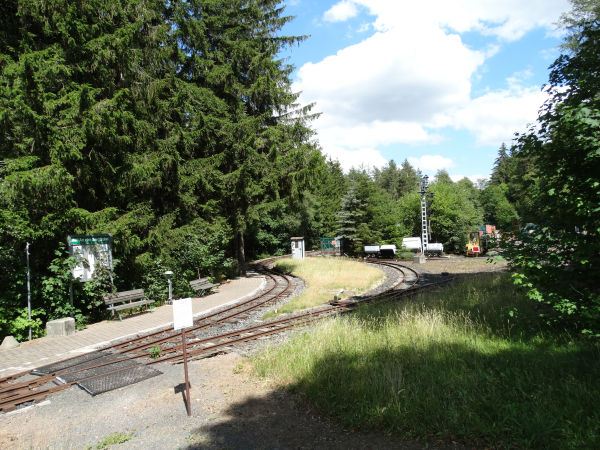
Quite next to the funicular station is a small private 600 mm gauge "Waldeisenbahn", forest railway. It has been built by members of the
railway hobbyist club Jenaer Eisenbahn-Verein. Members of the club have brought a large number of old 600mm gauge wagons and locomotives
to the site. The railroad has three stations. The railroad was opened in 1998 for the festivities of the 75th anniversary of the funicular.
The club claims that since 1998 over 30 000 people have already had a ride on their 600mm train. There is just one real passenger coach
available for these runs.
Picture from Lichtenhain "An der Bergbahn" station 2.7.2019 by Ilkka Siissalo.
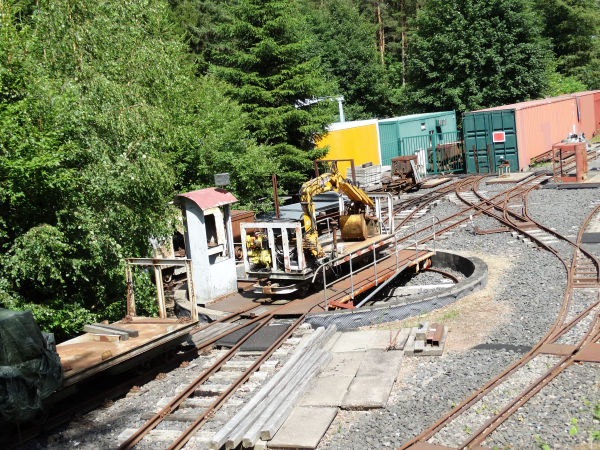
Turntable of the Lichtenhainer Waldeisenbahn. Containers are used for garages for wagons and locomotives.
Picture from Lichtenhain "An der Bergbahn" station 2.7.2019 by Ilkka Siissalo.
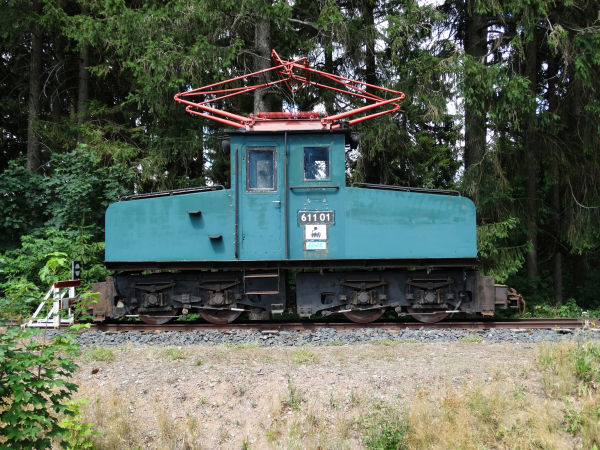
Lichtenhainer Waldeisenbahn has one electric locomotive, which is operated on batteries. The pantograph is only for charging the batteries
Picture from Lichtenhain "An der Bergbahn" station 2.7.2019 by Ilkka Siissalo.

